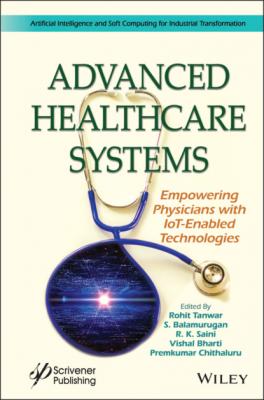Advanced Healthcare Systems. Группа авторов
Читать онлайн.| Название | Advanced Healthcare Systems |
|---|---|
| Автор произведения | Группа авторов |
| Жанр | Программы |
| Серия | |
| Издательство | Программы |
| Год выпуска | 0 |
| isbn | 9781119769279 |
350 345
351 346
352 347
353 348
354 349
355 350
356 351
357 352
358 353
359 354
360 355
361 356
362 357
Scrivener Publishing 100 Cummings Center, Suite 541J Beverly, MA 01915-6106
Artificial Intelligence and Soft Computing for Industrial Transformation
Series Editor: Dr. S. Balamurugan ([email protected])
Scope: Artificial Intelligence and Soft Computing Techniques play an impeccable role in industrial transformation. The topics to be covered in this book series include Artificial Intelligence, Machine Learning, Deep Learning, Neural Networks, Fuzzy Logic, Genetic Algorithms, Particle Swarm Optimization, Evolutionary Algorithms, Nature Inspired Algorithms, Simulated Annealing, Metaheuristics, Cuckoo Search, Firefly Optimization, Bio-inspired Algorithms, Ant Colony Optimization, Heuristic Search Techniques, Reinforcement Learning, Inductive Learning, Statistical Learning, Supervised and Unsupervised Learning, Association Learning and Clustering, Reasoning, Support Vector Machine, Differential Evolution Algorithms, Expert Systems, Neuro Fuzzy Hybrid Systems, Genetic Neuro Hybrid Systems, Genetic Fuzzy Hybrid Systems and other Hybridized Soft Computing Techniques and their applications for Industrial Transformation. The book series is aimed to provide comprehensive handbooks and reference books for the benefit of scientists, research scholars, students and industry professional working towards next generation industrial transformation.
Publishers at Scrivener
Martin Scrivener ([email protected]) Phillip Carmical ([email protected])
Advanced Healthcare Systems
Empowering Physicians with IoT-Enabled Technologies
Edited by
Rohit Tanwar,
S. Balamurugan,
R. K. Saini,
Vishal Bharti
and
Premkumar Chithaluru
This edition first published 2022 by John Wiley & Sons, Inc., 111 River Street, Hoboken, NJ 07030, USA and Scrivener Publishing LLC, 100 Cummings Center, Suite 541J, Beverly, MA 01915, USA
© 2022 Scrivener Publishing LLC
For more information about Scrivener publications please visit www.scrivenerpublishing.com.
All rights reserved. No part of this publication may be reproduced, stored in a retrieval system, or transmitted, in any form or by any means, electronic, mechanical, photocopying, recording, or otherwise, except as permitted by law. Advice on how to obtain permission to reuse material from this title is available at http://www.wiley.com/go/permissions.
Wiley Global Headquarters
111 River Street, Hoboken, NJ 07030, USA
For details of our global editorial offices, customer services, and more information about Wiley products visit us at www.wiley.com.
Limit of Liability/Disclaimer of Warranty
While the publisher and authors have used their best efforts in preparing this work, they make no representations or warranties with respect to the accuracy or completeness of the contents of this work and specifically disclaim all warranties, including without limitation any implied warranties of merchantability or fitness for a particular purpose. No warranty may be created or extended by sales representatives, written sales materials, or promotional statements for this work. The fact that an organization, website, or product is referred to in this work as a citation and/or potential source of further information does not mean that the publisher and authors endorse the information or services the organization, website, or product may provide or recommendations it may make. This work is sold with the understanding that the publisher is not engaged in rendering professional services. The advice and strategies contained herein may not be suitable for your situation. You should consult with a specialist where appropriate. Neither the publisher nor authors shall be liable for any loss of profit or any other commercial damages, including but not limited to special, incidental, consequential, or other damages. Further, readers should be aware that websites listed in this work may have changed or disappeared between when this work was written and when it is read.
Library of Congress Cataloging-in-Publication Data
ISBN 978-1-119-76886-9
Cover image: Pixabay.Com
Cover design by Russell Richardson
Set in size of 11pt and Minion Pro by Manila Typesetting Company, Makati, Philippines
Printed in the USA
10 9 8 7 6 5 4 3 2 1
Preface
The applications and challenges of machine learning and artificial intelligence in the internet of things for healthcare applications are comprehensively covered in this book. Rapid developments in hardware, software and communication technologies have facilitated the emergence of internet-connected sensory devices that provide observations and data measurements from the physical world. The technology of internet-connected devices, referred to as the internet of things (IoT), continues to extend the current internet by providing connectivity and interactions between the physical and cyber worlds. The IoT is undoubtedly transforming the healthcare industry by redefining the space of devices and interaction of people in delivering healthcare solutions, resulting in applications that benefit patients, families, physicians, hospitals and insurance companies. The use of remote monitoring in the healthcare sector possible with IoT-enabled devices has the potential to keep patients safe and healthy, and empowers doctors to provide superlative care, thereby increasing patients’ engagement and satisfaction as a result of their interactions with doctors becoming easier and more efficient. Furthermore, remote monitoring of patients’ health helps reduce the length of hospital stays and prevents readmissions, in addition to having a major impact on reducing healthcare costs significantly and improving treatment outcomes.
In addition to increasing volume, the IoT generates big data characterized by its velocity in terms of time and location dependency, with a variety of multiple modalities and varying data quality. Intelligent processing and analysis of this big data are the keys to developing smart IoT applications, thereby making space for machine learning (ML) applications. Due to its computational tools that can substitute for human intelligence in the performance
